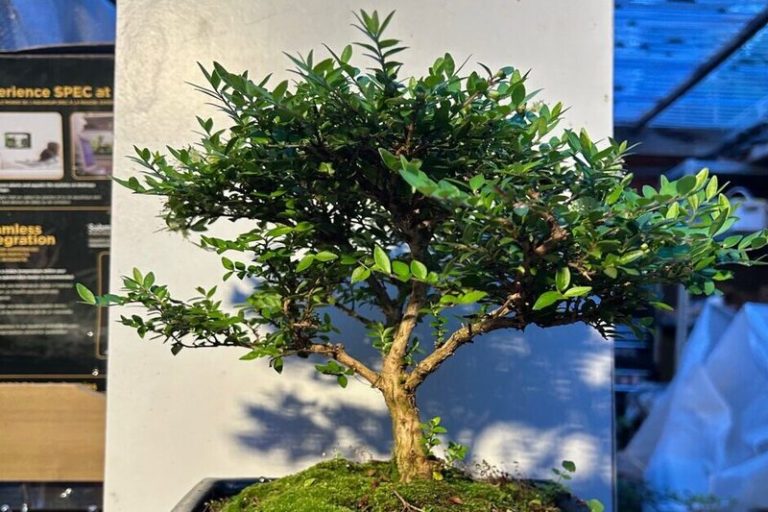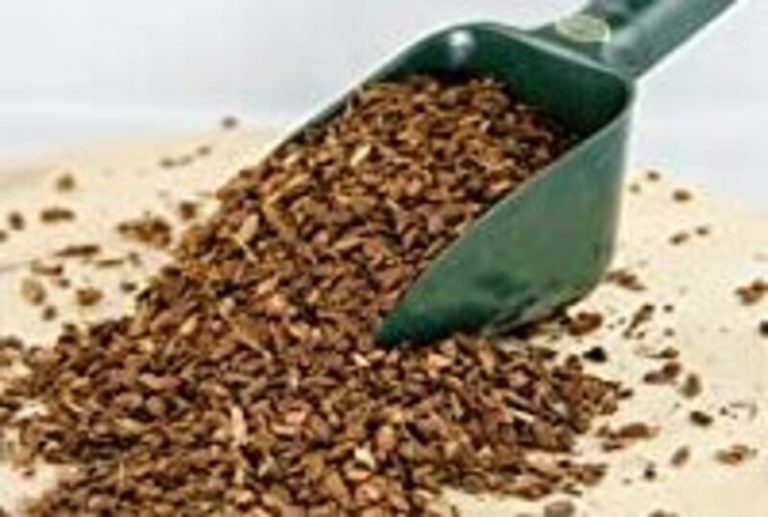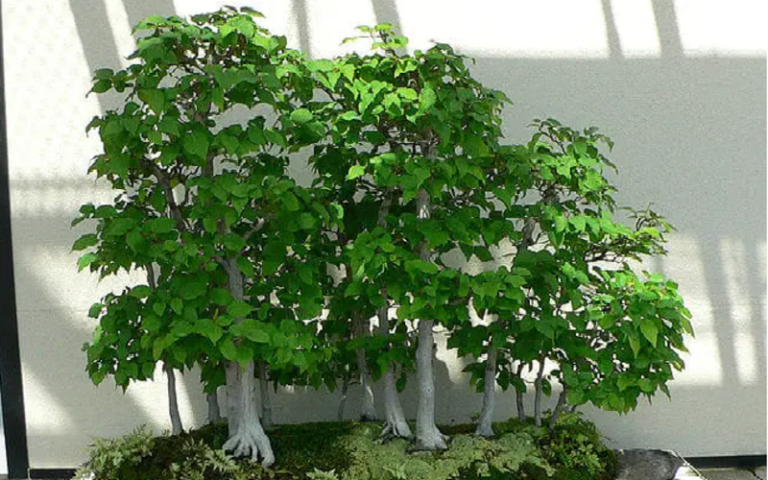Tanuki Bonsai: Creating the Illusion of Nature
Tanuki Bonsai is a traditional Japanese art form that involves creating a bonsai tree by attaching living branches from one tree to the trunk of another tree or deadwood. This unique technique creates an aesthetically pleasing and durable bonsai tree that is unlike any other.
What is Tanuki Bonsai?
Tanuki Bonsai is a unique form of bonsai tree that originated in Japan. It involves attaching living branches from one tree to the trunk of another tree or deadwood to create a natural-looking design. This technique creates a durable and long-lasting bonsai tree that is unlike any other.
Tanuki Bonsai is an important part of Japanese culture and custom. To make it, you need special tools, materials, and methods. Traditional bonsai methods can’t be used to make the same shape twice because they don’t use deadwood or special techniques.
History and Origins of Tanuki Bonsai
Tanuki Bonsai is a centuries-old Japanese art form. It is the process of connecting deadwood to a live tree to produce a natural-looking appearance. The practice of employing deadwood in bonsai is not new, but the Tanuki Bonsai style is thought to have been invented in the early twentieth century by a bonsai expert called Saburo Kato.
Over time, Kato used the technique to preserve old and damaged trees, and it eventually developed into an art form that bonsai enthusiasts all over the world admire. Today, Tanuki Bonsai is considered an important part of Japanese culture and tradition, and it requires specialized tools, materials, and techniques to create.
Famous Tanuki Bonsai Artists
There are several famous Tanuki Bonsai artists who have made significant contributions to the art form. Here are a few notable names:
Saburo Kato: mentioned earlier, Saburo Kato is widely recognized as the creator of the Tanuki Bonsai style. He was a bonsai expert who spread the practice of miniature gardening across the globe. Kato was also a driving force behind the establishment of Japan’s Omiya Bonsai Art Museum in Saitama.
Kimura Masakuni: Another famous bonsai artist who made a big impact on Tanuki Bonsai was Kimura Masakuni. Many of his original bonsai creations have received honors, and he is the third generation to lead the Masakuni bonsai tool firm.
Kunio Kobayashi: Kunio Kobayashi is a renowned bonsai artist renowned for his innovative Tanuki Bonsai creations. The Shunkaen Bonsai Museum in Tokyo, which he owns, is regarded as one of the finest bonsai museums in the world.
Masahiko Kimura: Masahiko Kimura is renowned for his innovative and inventive bonsai designs. In Japan, he owns the Kimura Bonsai Nursery, for which he has received numerous accolades. Kimura is renowned for his unconventional use of materials and techniques in the creation of his Tanuki Bonsai.
These artists have made substantial contributions to the art form of Tanuki Bonsai and have contributed to its global popularity. Their work continues to influence and inspire contemporary bonsai artists and enthusiasts.
Types of Tanuki Bonsai
Tanuki Bonsai come in a variety of styles, each with its own distinct traits and design. Some of the most prevalent Tanuki Bonsai varieties are:
1. Shari Tanuki: This type of Tanuki Bonsai uses deadwood to create a natural-looking design that resembles a tree that has been struck by lightning or damaged by wind.
2. Yose-ue Tanuki: This type of Tanuki Bonsai involves attaching multiple trees to the same trunk to create a group planting that looks like a natural forest.
3. Sekijoju Tanuki: This type of Tanuki Bonsai uses a single living tree as the base, and deadwood is attached to create a unique and natural-looking design.
4. Ishitsuki Tanuki: This type of Tanuki Bonsai involves using rocks as the base, with living trees and deadwood attached to create a natural-looking design that resembles a rocky landscape.
5. Ikadabuki Tanuki: This type of Tanuki Bonsai involves attaching multiple dead branches to a single living trunk to create a unique and natural-looking design.
Each form of Tanuki Bonsai necessitates a distinctive set of techniques and materials, and the final bonsai tree has its own distinct beauty and charm.

Tanuki Bonsai and Its Symbolism
Tanuki Bonsai is an art form that combines the natural beauty of living trees with the rugged charm of deadwood. The use of deadwood in Tanuki Bonsai is not merely decorative but also carries symbolic meaning.
In Japanese culture, deadwood is associated with the concept of “wabi-sabi,” which is the acceptance of imperfection and transience. In Tanuki Bonsai, deadwood is used to represent the impermanence of life and the passage of time. The use of deadwood also symbolizes the harshness of nature and the resilience of living trees.
The living part of the Tanuki Bonsai tree represents vitality, growth, and the beauty of nature. The deadwood, on the other hand, represents the struggle and hardships that the tree has endured. By combining the two, Tanuki Bonsai artists create a powerful symbol of the resilience of life and the beauty of imperfection.
The significance of Tanuki Bonsai transcends the use of deadwood alone. Bonsai is often viewed as a form of meditation and spiritual practice. The bonsai tree itself is a symbol of harmony and balance. In Japanese culture, bonsai is also associated with “mono no aware,” which is an appreciation for the transient beauty of life.
Overall, Tanuki Bonsai is a powerful symbol of the beauty and resilience of nature, and the impermanence of life. The art form combines the natural beauty of living trees with the rugged charm of deadwood to create a unique and inspiring work of art.
Characteristics of Tanuki Bonsai
Tanuki Bonsai is a unique form of bonsai that has several distinguishing characteristics. Here are some of the key characteristics of Tanuki Bonsai:
Deadwood: One of the defining characteristics of Tanuki Bonsai is the use of deadwood. Deadwood is often used to create the illusion of a naturally aged tree or to cover up scars or damage to the trunk of the bonsai. The deadwood is carefully selected and attached to the living tree using specialized techniques to create a seamless and natural-looking design.
Durability: Tanuki Bonsai is known for its durability and resistance to decay and pests. The use of deadwood makes the bonsai tree more resilient and long-lasting, which is one of the reasons it is favored by bonsai enthusiasts.
Unique Design: Each Tanuki Bonsai tree is one-of-a-kind and distinct. No two Tanuki Bonsai trees are identical due to the use of deadwood and the specialized techniques employed to adhere it to the living tree.
Symbolism: Tanuki Bonsai often carries symbolic meaning, as the use of deadwood represents the impermanence of life and the passage of time. The living part of the bonsai tree represents vitality and growth, while the deadwood represents struggle and hardship.
Requires Skill: The creation of Tanuki Bonsai requires specialized instruments, materials, and techniques. Bonsai artists who specialize in Tanuki Bonsai must have a comprehensive understanding of the techniques and materials necessary to create an attractive and long-lasting bonsai tree.
Overall, Tanuki Bonsai is a beautiful and distinctive form of bonsai that requires skill, perseverance, and a profound appreciation for the natural beauty. Its durability and symbolic significance make it a favorite among bonsai enthusiasts worldwide.

How to Create Tanuki Bonsai
Creating a Tanuki Bonsai is a unique and specialized process that requires patience, skill, and knowledge of bonsai techniques. Here are the general steps involved in creating a Tanuki Bonsai:
- Choose a suitable tree: Select a tree that has a natural and interesting shape with some deadwood present on the trunk. The best trees for Tanuki Bonsai are those that have been damaged by weather or disease, or those that have been cut down and left to age naturally.
- Select a suitable piece of deadwood: Choose a piece of deadwood that complements the thriving tree’s shape and size. The deadwood must be robust and long-lasting, with a natural-looking texture and hue.
- Prepare the deadwood: The deadwood should be cleaned and treated to prevent decay and pests. The bark and soft wood should be removed, leaving only the hard, durable core.
- Attach the deadwood to the living tree: Use specialized techniques, such as jin and shari, to attach the deadwood to the living tree. The process involves drilling holes in the living tree and inserting the deadwood, then securing it with wire or nails.
- Shape the tree: Shape the living tree using bonsai techniques such as pruning and wiring to create a natural-looking and balanced design.
- Care for the tree: The maintenance of Tanuki Bonsai includes watering, fertilizing, and repotting. The tree should be set in an appropriate location, such as a sunny window or outdoor garden, and should be shielded from extreme weather conditions.
Creating a Tanuki Bonsai is a difficult and rewarding process that requires a profound appreciation for the natural beauty and bonsai art. Anyone with perseverance, talent, and commitment can construct a beautiful and unique Tanuki Bonsai tree.
Benefits of Tanuki Bonsai
Tanuki Bonsai offers several benefits, both aesthetic and practical, for bonsai enthusiasts. Here are some of the main benefits of Tanuki Bonsai:
Durability: The longevity of Tanuki Bonsai is a major benefit. Those looking for a low-maintenance bonsai tree can’t do better than one that incorporates deadwood into its design.
Unique design: The distinctive style of a Tanuki Bonsai is well-recognized. Because of the unique methods used to attach the deadwood to the living tree, no two Tanuki Bonsai trees are ever the same.
Symbolism: Tanuki Bonsai often carries symbolic meaning, as the use of deadwood represents the impermanence of life and the passage of time. This makes it an ideal choice for those who value the deeper meaning behind bonsai art.
Aesthetics: Tanuki Bonsai is a visually striking form of bonsai that adds beauty and interest to any setting. The use of deadwood creates a natural and aged appearance that is both elegant and rustic.
Improved well-being: Caring for a Tanuki Bonsai can be a relaxing and therapeutic activity that promotes a sense of calm and well-being. The process of shaping and caring for the tree can be a meditative and rewarding experience.
Overall, Tanuki Bonsai is a unique and attractive type of bonsai that provides a variety of benefits to individuals who respect the art of bonsai. Its longevity, unusual design, symbolism, beauty, and therapeutic effects make it a favorite option among bonsai aficionados all over the world.
Styling and Design of Tanuki Bonsai
Styling and designing a Tanuki Bonsai involves several unique techniques and considerations. Here are some key factors to keep in mind when creating a Tanuki Bonsai design:
1. Selecting the right tree: Choose a tree that has a natural and interesting shape, with some deadwood present on the trunk. The tree’s shape should be conducive to incorporating the deadwood into the design.
2. Choosing the right deadwood: Deadwood should be picked for its size, form, and texture, and it should compliment the shape and color of the living tree. The deadwood should have a natural texture and color that matches that of the living tree.
3. Attaching the deadwood: Use specialized techniques, such as jin and shari, to attach the deadwood to the living tree. The deadwood should be attached in a way that looks natural and blends in with the living tree.
4. Shaping the tree: Shape the living tree using bonsai techniques such as pruning and wiring to create a natural-looking and balanced design. The living tree should be shaped to complement the deadwood, creating a harmonious overall design.
5. Adding finishing touches: Once the living tree and deadwood are integrated, add any finishing touches, such as moss or rocks, to complete the design. These elements should complement the overall design and add to the tree’s natural appearance.
6. Maintenance: Tanuki Bonsai requires regular maintenance, including watering, fertilizing, and repotting. It’s essential to keep the tree healthy and balanced to ensure the longevity of the design.
Styling and designing a Tanuki Bonsai can be both difficult and rewarding. You can create a unique and beautiful design that showcases the majesty of nature and the art of bonsai by paying meticulous attention to detail.
How to Care and Maintain Tanuki Bonsai
Caring and maintaining a Tanuki Bonsai requires some specific techniques and considerations. Here are some essential tips for keeping your Tanuki Bonsai healthy and thriving:
- Watering: Tanuki Bonsai should be watered regularly, taking care not to overwater or submerge the tree. Check the soil moisture level regularly, and water the tree only when the soil feels slightly dry.
- Fertilizing: Fertilize your Tanuki Bonsai every two to four weeks during the growing season, using a balanced liquid fertilizer. Reduce fertilization during the dormant season.
- Pruning: Prune your Tanuki Bonsai regularly to maintain its shape and promote healthy growth. Use sharp pruning shears to remove any dead or damaged branches, and trim back the tree’s foliage to maintain its desired shape.
- Wiring: Wiring is often used to shape Tanuki Bonsai, but take care not to wire the deadwood as it can be brittle and break easily. Use caution when wiring the living tree, making sure not to damage the bark.
- Repotting: Tanuki Bonsai should be repotted every two to three years to ensure healthy growth. Repotting is best done in the spring or fall using a well-draining soil mixture.
- Protection: Protect your Tanuki Bonsai from extreme temperatures, winds, and direct sunlight. Keep the tree in a sheltered location during hot summer days or cold winter nights.
- Cleaning: Keep your Tanuki Bonsai clean by regularly removing any dust or debris from the deadwood and foliage. You can use a soft brush or a gentle spray of water to clean the tree.
By following these essential guidelines, you can keep your Tanuki Bonsai healthy and flourishing for years to come. With appropriate care and maintenance, your Tanuki Bonsai will continue to bring beauty and pleasure to your home or garden.
Tanuki Bonsai care sheet
| Aspect | Care Tips |
|---|---|
| Watering | Water regularly, avoid overwatering or underwatering |
| Fertilizing | Use a balanced liquid fertilizer every 2-4 weeks |
| Pruning | Regularly prune dead or damaged branches, trim foliage |
| Wiring | Use caution when wiring the living tree to avoid damaging it |
| Repotting | Repot every 2-3 years using a well-draining soil mixture |
| Protection | Protect from extreme temperatures, winds, and direct sunlight |
| Cleaning | Regularly remove dust and debris from deadwood and foliage |
These are just brief tips, and it’s important to research and follow specific care instructions for your individual Tanuki Bonsai tree to ensure its health and longevity.
FAQ:
Q: What is a Tanuki Bonsai?
A: A Tanuki Bonsai is a type of bonsai tree that is created by attaching the living branches of a young tree to the dead trunk of an old tree. The dead trunk is then carved and shaped to create the appearance of a single, old tree.
Q: How is a Tanuki Bonsai created?
A: To create a Tanuki Bonsai, a living tree is selected, and its branches are grafted onto the dead trunk of an old tree. The dead trunk is then carved and shaped to match the contours of the living branches.
Q: Can any type of tree be used to create a Tanuki Bonsai?
A: Almost any type of tree can be used to create a Tanuki Bonsai. However, trees with a naturally gnarled or twisted appearance, such as junipers, are often preferred because they lend themselves well to the creation of deadwood features.
Q: How do I care for my Tanuki Bonsai?
A: The maintenance of a Tanuki Bonsai is analogous to that of other bonsai trees. Maintaining the tree’s health and form requires consistent irrigation, fertilization, pruning, and repottering. Also essential is protection from extreme temperatures, wind, and direct sunlight.
Q: Can a Tanuki Bonsai be wired like other bonsai trees?
A: Yes, a Tanuki Bonsai can be wired to shape its branches, but care must be taken not to damage the living tree while wiring the deadwood.
Q: Is a Tanuki Bonsai more difficult to care for than other bonsai trees?
A: Caring for a Tanuki Bonsai requires the same amount of care and attention as other bonsai trees. However, the deadwood features of a Tanuki Bonsai require additional care to avoid cracking or breaking.
Also Read:







